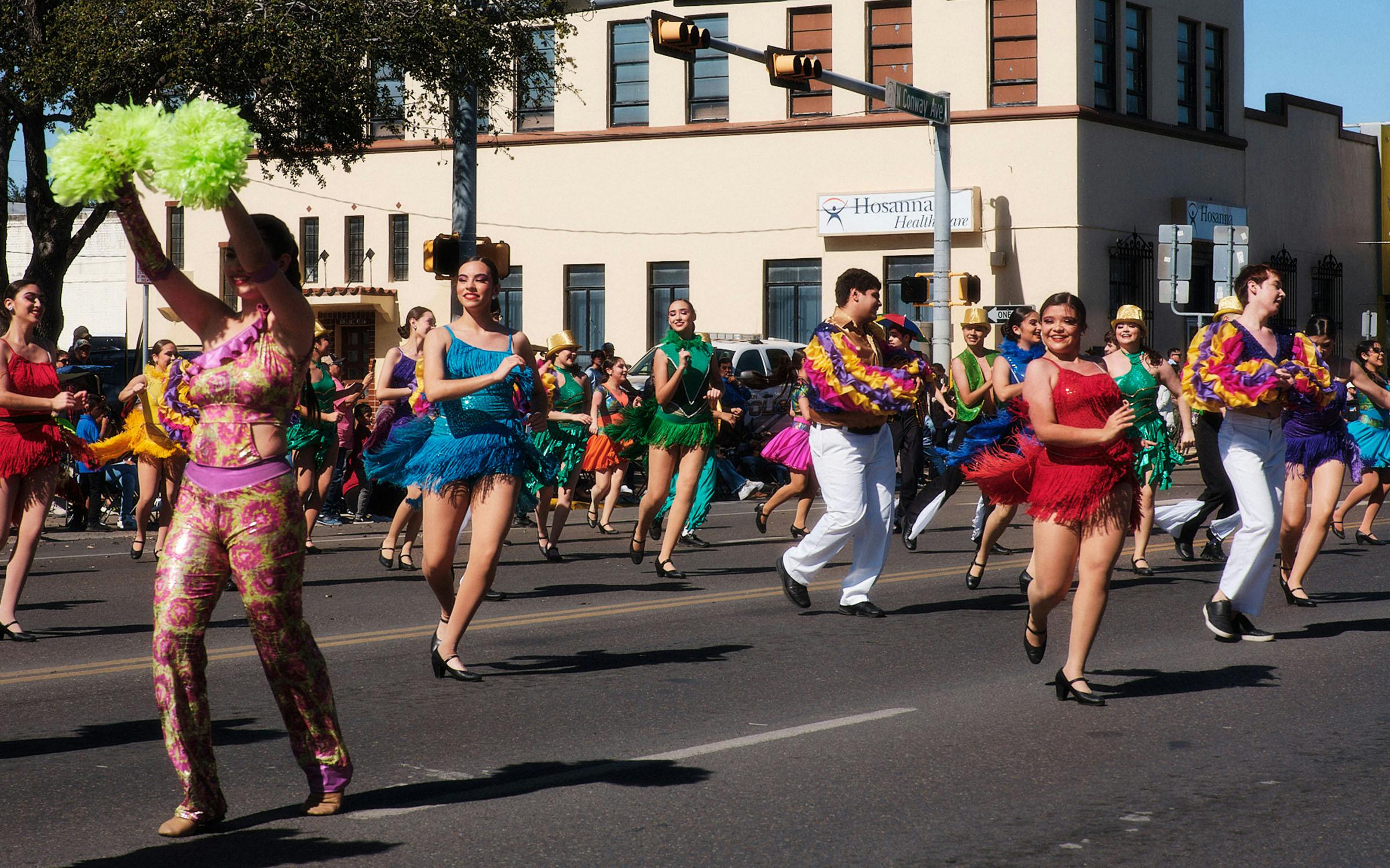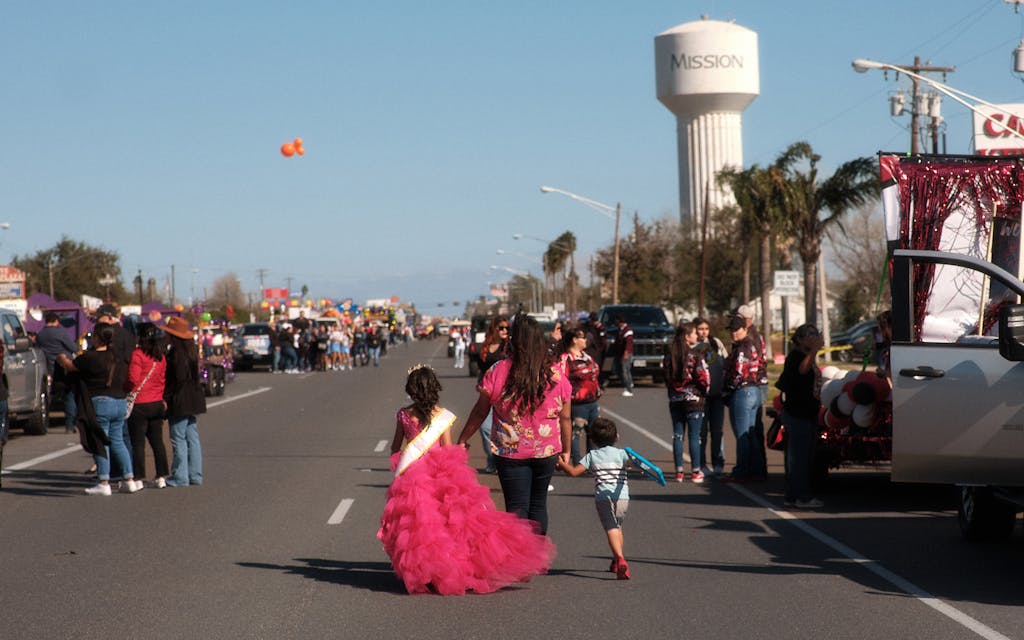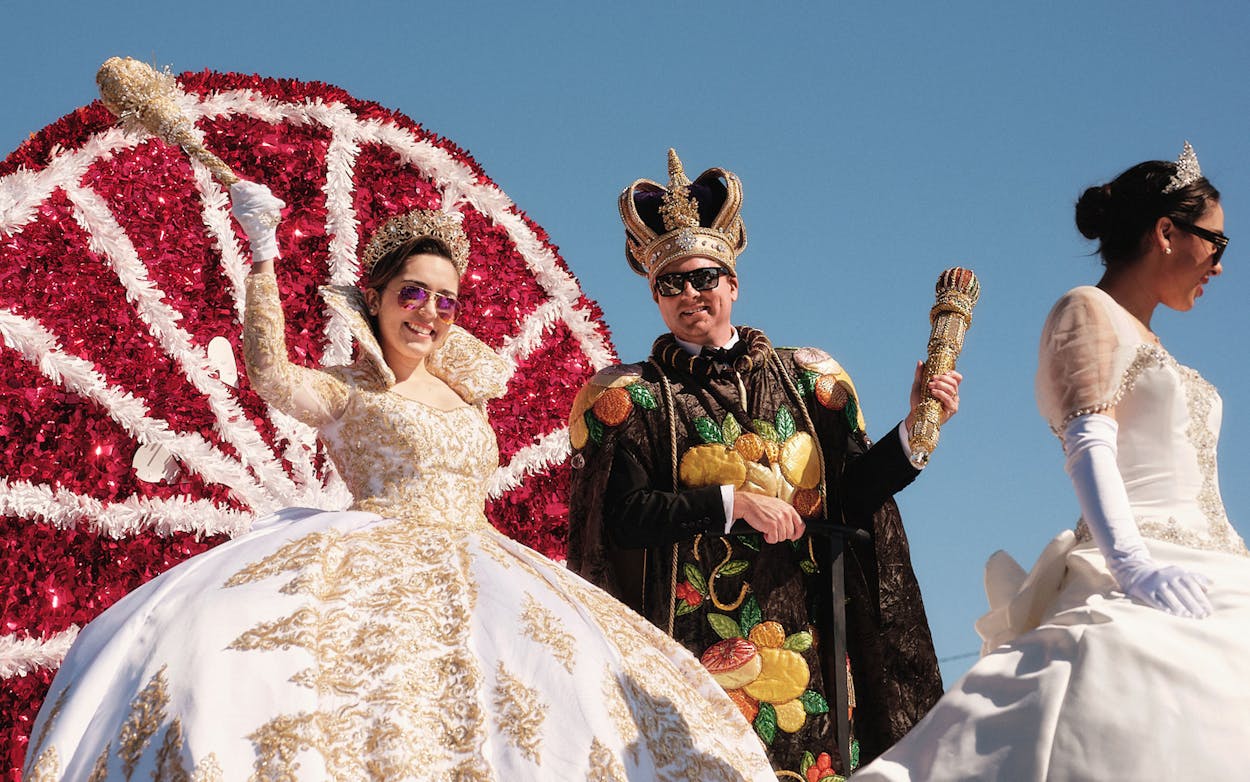About fifty folding chairs are lined up in front of the Border Theater in downtown Mission, a town of 86,000 just west of McAllen. The row of onlookers is composed mostly of multigenerational families, from toddlers to grandparents. They all gaze north toward the parade coming down North Conway Avenue, and many hold up their hands to block the sun that pierces through this breezy January morning. R. J. Gonzalez and his wife, Eva, are waiting for the float carrying their sixteen-year-old granddaughter, Natalia Flores. Today she’s the Princess of Emerald Dove, a dignitary of the White Wing Royal Court, representing the neighboring city of Peñitas. Over the din of police sirens and tejano music pumping from speakers on the parade floats, Flores shows me a picture of a pig-feed box he built for Natalia’s 4-H club. The box has a painting of her pig, all black except for a white stripe that wraps around its neck and front legs.
Like the scent of a grapefruit that lingers on your hand after you peel it, the sights and smells of citrus stick to everything here. Mayor Norie Gonzalez Garza and city councilwoman Jessica Ortega wear matching tangerine-colored blazers, and they each carry a purse shaped like an orange wedge. The MC onstage, Homer Garza, wears a blazer of deep red and orange checkers that shimmer in the sun. Next to the stage, the art deco facade of the 82-year-old Border Theater is the color of orange sherbet.


An eighteen-wheeler approaches the theater, its flatbed piled almost five feet high with hundreds of oranges. The truck idles for a minute, and Gonzalez calls to the driver to toss him some fruit: “¡Tirame una!” Another man in the crowd joins in, shouting, “¡Que tengo hambre! ¡Mi esposa no me hace desayuno!” (“I’m hungry! My wife doesn’t make me breakfast!”) The driver tosses him nothing but a nod, then moves on.
This is the Parade of Oranges, the biggest event in Mission’s 92-year-old Texas Citrus Fiesta. About 12,000 people are attending this year’s parade, which, as always, boasts floats covered in hundreds of fresh slices of oranges, grapefruits, and limes. The sheer volume of real decorative fruit on trailer after trailer evokes an image of dozens of hands slicing and stapling fruit to each float’s wooden base.
Oscar Martinez, board president for the Texas Citrus Fiesta, tells me that this image isn’t far off the mark. The month-long festival is put together by more than a thousand volunteers, many of whom ask local fruit packers and grocers for donations of surplus produce to stick to the floats and to the dresses and suits in the Product Costume Show, in which contestants wear vests, hats, and dresses painstakingly adorned with citrus rinds, palm leaves, and other natural materials. These events require an immense volume of labor and design ingenuity. The display for the White Wing Royal Court of Peñitas, for instance—one of forty floats in the parade—was assembled by more than a dozen volunteers over three days.

The Duchess of White Wing is one of sixteen teenage duchesses who ride atop the floats in stunning gowns, along with younger princesses from the elementary school–level Tangerine Court. The duchesses from Mission and several other Rio Grande Valley towns all vie for the title of Queen Citrianna. They include the Duchess of Lemon, the Duchess of Marsh White Seedless Grapefruit, the Duchess of Rio Red (not to be confused with the Duchess of Ruby Red), and a few outliers (citrus-wise), such as the Duchess of Grain Sorghum. Other members of the court represent plants and animals essential to the Valley’s ecology. The Duchess Butterfly wears a dark dress that unfurls like a monarch’s wings, and the Duchess of Retama is clad in a yellow dress whose small ruffles mimic the flowers of the retama shrubs that bloom all spring here. The Duchess of Delta Waters’s aqua dress shines like the waters of the long arroyos, fed by the Rio Grande, that cut through the Valley and nourish its citrus groves.
Against shades of yellow and orange, the immaculate white dress of the eighty-seventh Queen Citrianna is blinding in the sun. This year’s queen is Riza Renae Hernandez, a high school senior in McAllen, who was elevated from the title of Duchess of Palms, named after the ubiquitous trees of her hometown. She describes the rigorous interview process required for the title: “I had to learn about different palm trees, those that are native to the Valley and unique to my community,” Hernandez says. “You might wonder how a palm tree fits into a citrus event, but palms have been used to act as a shadow for citrus crops, to prevent them from getting too much sun.”

The Texas Citrus Fiesta began in 1932, when leaders in Mission sought a way to promote the rapidly growing industry and celebrate its winter harvest. The community festival has run almost continuously every winter since then, with a few years interrupted by World War II and a hurricane. Though the event is run by the City of Mission, considered the birthplace of the Texas citrus industry, it attracts revelers from all over the Valley. Many communities that participate—including Mercedes, Donna, and Mission—are connected by the historic route of the railroad that sparked the industry in the first decade of the 1900s, when early growers could finally get their product to faraway markets.
Shortly after the railroad arrived, the budding industry attracted outside investors like Nebraska native John Shary, nicknamed the “Father of the Texas Citrus Industry.” He was followed by other entrepreneurs on a similar trajectory, with many moving from harsh northern climates to the warm Rio Grande Valley. In the early twentieth century, doctors often recommended relocating to a warm climate as a treatment for various ailments. That’s what brought Ray Landry, father of famed Dallas Cowboys coach Tom Landry, from Illinois to Mission in 1912, seeking milder air that might help his rheumatism. Mission “has never been and never will be a glamour spot,” wrote Tom Landry in his 1990 autobiography. “But there wasn’t a prettier-smelling place on earth when the wind would waft the sweet fragrance of flowering lemon, orange, and grapefruit in from the great citrus groves stretching up and down the valley.” Now the town’s favorite son watches over the procession of the Parade of Oranges from his mural on Tom Landry Street.
This year’s King Citrus is 44-year-old Russon Holbrook, whose grandparents similarly moved from Utah in the 1950s. Holbrook carries the title as a representative of South Tex Organics, the citrus company that his father founded. In the early 1980s, researchers from Texas A&M University tested his father and other farmers for residual pesticides and herbicides in their bodies. According to Holbrook, his father tested higher than the other farmers due to his lifelong work in the citrus groves. “That changed my father’s mindset, and the organic transition began,” he says. “In 1984, he established South Tex Organics. He began selling produce to two Whole Foods stores in Austin, and today we ship organic citrus to Whole Foods stores across the country.”


Only a small sliver of all citrus grown in the United States comes from Texas. The Lone Star State produced less than 3 percent of all U.S. citrus in the 2022–23 season, according to the U.S. Department of Agriculture. California farmers grew 79 percent of American citrus last year, with Florida at a distant second (about 17 percent). But Texas excels when it comes to grapefruit, producing 90,000 tons of the fruit to Florida’s 77,000 tons last year (California remains number one, growing an astounding 160,000 tons of grapefruit last year). The Ruby Red is a distinct Texas varietal, first grown in 1929 as the result of a genetic mutation and patented in 1934. So it’s not surprising that grapefruit has a central role at the fiesta. Russon’s daughter, Elle Holbrook, was just crowned the next Queen Citrianna after serving as the Duchess of Rio Red Grapefruit.
While the citrus industry is estimated to bring more than $100 million to the Texas economy each year, it’s not what it once was. The value of the Texas citrus industry today is only about 20 percent of its value in 1980. The risk of severe freezes, which crippled the state’s crops in 1983, 1989, and 2021, makes this a tough business that many farmers have chosen to leave. That volatility is coupled with other challenges including development, rising property values, and irrigation difficulties. “The citrus community once upon a time was very big, so you had a lot more growers and packinghouses around here,” says Holbrook. “What used to be a citrus grove is now an RV park, a neighborhood, or a strip mall.”
An outside observer of the vibrant festivities would never know that we were past the golden age of citrus, a testament to the power of elaborate community festivals to keep traditions alive. Amy Tijerina, the fiesta’s interim executive director, started the job just a few weeks before the events kicked off, leaving her scrambling to organize the royal coronation, royal ball, and parade—but she says the long days were well worth it. “I poured my heart and soul into this for my community and the girls involved,” Tijerina says. “Every year a child that attends the parade will smile and never forget it.”

Once the parade wrapped up, the families dispersed into the funfair directly behind the stage. After a morning of snacking on mountains of free fruit wedges, attendees cleansed their citrus palates with the hearty food of South Texas. Second only to citrus on the food hierarchy here is the espiropapa, the favorite of the newly anointed Queen Citrianna, consisting of a whole potato sliced into a long Slinky shape, put on a stick, and lightly fried.
Next to the frying station, attendees lined up to squirt white and red sauces onto their spirals, leaving what looked like an ever-evolving Jackson Pollock painting on a tray that caught the drippings. Some spritzed their spirals with what looked at first like a bottle of cleaning liquid but was actually lime-juice mist: citrus literally in the air.
- More About:
- Texas History
- Festivals
- Mission






